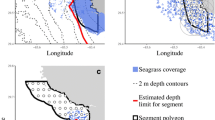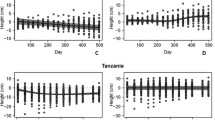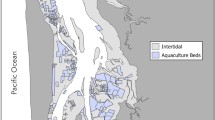Abstract
Seagrass protection and restoration in Florida’s Indian River Lagoon system (IRLS) is a mutual goal of state and federal programs. These programs require, the establishment of management targets indicative of seagrass recovery and health. We used three metrics related to seagrass distribution: areal coverage, depth limit, and light requirement. In order to account for the IRLS’s spatial heterogeneity and temporal variability, we developed coverage and depth limit targets for each of its 19 segments. Our method consisted of two steps: mapping the union of seagrass coverages from all availabe mapping years (1943, 1986, 1989, 1992, 1994, 1996, and 1999) to delineate wherever seagrass had been mapped and determining the distribution of depth limits based on 5,615 depth measurements collected on or very near the deep-edge boundary of the union coverage. The frequency distribution of depth limits derived from the union coverage, along with the median (50th percentile) and maximum (95th percentile) depth limits, serve as the seagrass depth targets for each segment. The median and maximum depth targets for the IRLS vary among segments from 0.8 to 1.8 and 1.2 to 2.8 m, respectively.Halodule wrightii is typically the dominant seagrass species at the deep-edge of IRLS grass beds. We set light requirement targets by using a 10-yr record of light data (1990–1999) and the union coverage depth limit distributions from the most temporally stable seagrass segments. The average annual light requirement, based on the medians of the depth limit distributions, is 33 ± 17% of the subsurface light. The minimum annual light requirement, based on of the 95th percentile of the depth distributions, is 20 ± 14%; the minimum growing season light requirement (March to mid September) is essentially the same (20 ± 13%). Variation in depth limits and light requirements, is probably due to factors other than light that influence the depth limit of seagrasses (e.g., competition, physical disturbance). The methods used in this study are robust when applied to large or long-term data sets and can be applied to other estuaries where grass beds are routinely monitored and mapped.
Similar content being viewed by others
Literature Cited
Applied Biology, Inc. and R. L. Lyerly and Association. 1980. Biological and environmental studies at the Florida Power and Light Company, Cape Canaveral plant and the Orlando Utilities, Indian River plant. Volume 1. Available at Marine Resources Council of East Central Florida. Rockledge, Florida.
Bulthuis, D. A. 1983. Effects of in situ light reduction on density and growth of the seagrassHeterozostera tasmanica (Martens ex Ascers.) den Hartog in Western Port, Victoria, Australia.Journal of Experimental Marine Biology and Ecology 67:91–103.
Bulthuis.,D. A. andW. J. Woelkerling. 1983. Biomass accumulation and shading effects of epiphytes on leaves of the seagrassHeterozostera tasmanica, in Victoria, Australia.Aquatic Botany 16:137–148.
Burd, A. B. andK. H. Dunton. 2001. Field verification of a light-driven model of biomass changes in the seagrassHalodule wrightii.Marine Ecology Progress Series 209:85–98.
Carlson, P. R., L. A. Yarbro andT. R. Barber. 1994. Relationship of sediment sulfide to mortality ofThalassia testudinum in Florida Bay.Bulletin of Marine Science 54:733–746.
Coastal Planning and Engineering. 1997. Indian River Lagoon bathymetric survey. A final report to St. Johns River Water Management District, (Contract #95W142). Palatka, Florida.
Cowper, S. W. 1978. The drift algae community of seagrass beds in Redfish Bay, Texas.Contributions in Marine Science 21:125–132.
Davis, M. W., C. Zimmermann, andJ. Montgomery. 1983. Sediment-associated macroalgae act as biological filters in estuaries.Estuaries 6:312.
den Hartog, C. 1994. Suffocation of a littoralZostera bed byEnteromorpha radiata.Aquatic Botany 47:21–28.
den Hartog C. andP. J. G. Polderman. 1975. Changes in the seagrass populations of the Dutch Waddenzee.Aquatic Botany 1:141–147.
Dennison, W. C. 1987. Effects of light on seagrass photosynthesis, growth, and depth distributions.Aquatic Botany 27:15–26.
Dixon, L. K. 2000. Establishing light requirements for the seagrassThalassia testudinum: An example from Tampa Bay, Florida, p. 9–31.In S. A. Bortone (ed.), Seagrasses: Monitoring, Ecology, Physiology, and Management. CRC Press, Marine Science Series, Boca Raton, Florida.
Dixon, L. K. and G. Kirkpatrick. 1995. Light attenuation with respect to seagrasses in Sarasota Bay, Florida. Sarasota Bay National Estuary Program, Mote Marine Laboratory Report No. 407. Available from: Mote Marine Laboratory Library. Sarasota Bay, Florida.
Duarte, C. M. 1991. Seagrass depth limitsAquatic Botany 40:363–377.
Dobson, J. E., E. A. Bright, R. L. Ferguson, D. W. Field, L. L. Wood, K. D. Haddad, H. Iredale, III,J. R. Jensen, V. V. Klemas, R. J. Orth, andJ. P. Thomas. 1995. NOAA Coastal Change Analysis Program (C-CAP) Guidance for Regional Implementation. NOAA Technical Report NMFS 123. National Oceanic and Atmospheric Administration, Seattle, Washington.
Dunton, K. H. 1994. Seasonal growth and biomass of the subtropical seagrassHalodule wrightii in relation to continuous measurements to underwater irradiance.Marine Biology 20:479–489.
Dunton, K. H. 1996. Photosynthetic production and biomass of the subtropical seagrassHalodule wrightii along an estuarine gradient.Estuaries 19:436–447.
Estevez, E. D. and M. J. Marshall. 1993. Sebastian River salinity regime, parts III and IV: Recommended targets. Final report to St. Johns River Water Management District (Contract #92W177), Palatka, Florida.
Evink, G. L. 1980. Studies of the causeways in the Indian River, Florida. Final report to the Florida Department of Transportation, FL-ER-7-80. Tallahassee, Florida.
Fonseca M. S. andS. S. Bell. 1998. Influence of physical setting on seagrass landscapes near Beaufort, North Carolina, USA.Marine Ecology Progress Series 171:109–121.
Gallegos, C. L. andW. J. Kenworthy. 1996. Seagrass depth limits in the Indian River Lagoon (Florida, U.S.A.): Application of an optical water quality model.Estuarine Coastal and Shelf Science 42:267–288.
Hanisak, M. D. 2001. Photosynthetically active radiation, water quality, and submerged aquatic vegetation in Indian River Lagoon. Final report to St. Johns River Water Management District (Contract #93W199), Palatka, Florida.
Harden, S. W. 1994. Light requirements, epiphyte load and light reduction for three seagrass species in the Indian River Lagoon, Florida. M.S. Thesis, Florida Institute of Technology, Melbourne, Florida.
Hauxwell, J., J. Cebrian, C. Furlong andI. Valiela. 2001. Macroalgal canopies contribute to eelgrass (Zostera marina) decline in temperate estuarine ecosystems.Ecology 82:1007–1022.
Janicki, A. and D. Wade. 1996. Estimating critical nitrogen loads for the Tampa Bay estuary: An empirically based approach to setting management targets. Tampa Bay National Estuary Program. Coastal Environmental, Inc., Technical Publication 06-96. St. Petersburg, Florida.
Johansson, J. O. R. 2002. Water depth (MTL) at the deep edge of seagrass meadows in Tampa Bay measured by GPS carrier-phase processing: Evaluation of the technique, p. 151–168.In H. S. Greening (ed.), Seagrass Management: It’s Not Just Nutrients! Tampa Bay Estuary Program, proceedings of a symposium, St. Petersburg, Florida.
Johansson, J. O. R. and H. Greening. 2000. Seagrass restoration in Tamp Bay: A resource-based approach to estuarine management, p. 279–293.In S. A. Bortone (ed.), Seagrasses: Monitoring, Ecology, Physiology, and Management. CRC Press, Marine Science Series. Boca Raton, Florida.
Kemp, W. M., R. Batiuk, R. Bartleson, P. Bergstrom, V. Carter, C. L. Gallegos, W. Hunley, L. Karrh, E. W. Koch, J. M. Landwehr, K. A. Moore, L. Murray, M. Naylor, N. B. Rybicki, J. C. Stevenson, andD. J. Wilcox. 2004. Habitat requirements for submerged aquatic vegetation in Chespeake Bay: Water quality, light regime, and physical-chemical factors.Estuaries 27:363–377.
Kemp, W. M., W. R. Boynton, L. Murray, C. J. Madden, R. L. Wetzel, andF. Vera Herrera. 1988. Light relations for the seagrassThalassia testudinum, and its epiphytic algae in a tropical estuarine environment, p. 193.In A. Yáñez-Arancibia and J. W. Day Jr. (eds.), Ecology of Coastal Ecosystems in the Southern Gulf of Mexico: The Terminus Lagoon Region. Instituto de Ciencias del May y Limnologia, Universidad Nacional Autonoma de Mexico, Mexico.
Kenworthy, W. J. andM. S. Fonseca. 1996. Light requirements of seagrassesHalodule wrightii andSyringodium filiforme derived from the relationship between diffuse light attenuation and maximum depth distribution.Estuaries 19:740–750.
Kirk, J. T. O. 1983. Light and Photosynthesis in Aquatic Ecosystems. Cambridge University Press, Cambridge, U.K.
Kirk, J. T. O. 1994. Light and Photosynthesis in Aquatic Ecosystems. 2nd edition. Cambridge University Press, Cambridge, U.K.
Koch, E. W. 2001. Beyond light: Physical, geological, and geochemical parameters as possible submersed aquatic vegetation habitat requirements.Estuaries 24:1–17.
Martin, J. B., J. Jaeger, and J. Cable. 2004. Quantification of advective benthic processes contributing nitrogen and phosphorus to surface waters of the Indian River Lagoon. Final report to St. Johns River Water Management District (Contract #SG458AA), Palatka, Florida.
McMahan, C. A. 1968. Biomass and salinity tolerance of shoal grass and manatee grass in Lower Laguna Madre, Texas.Journal of Wildlife Management 32:501–506.
Miller, R. R. 1997. Spatial distribution of epiphyte loadings on seagrass (Halodule wrightii) in the Indian River Lagoon, Florida. M.S. Thesis, Florida Institute of Technology, Melbourne, Florida.
Miller-Myers, R. R. and R. W. Virnstein. 2000. Development and use of an Epiphyte Photo Index (EPI) for assessing epiphyte loadings on the seagrassHalodule wrightii, p. 115–123.In S. A. Bortone (ed.), Seagrasses: Monitoring, Ecology, Physiology, and Management. CRC Press, Marine Science Series, Boca Raton, Florida.
Morris, L. J. and D. A. Tomasko (eds.). 1993. Proceedings and conclusions of workshops on: Submerged aquatic vegetation and photosynthetically active radiation. Special Publication SJ93-SP13. St. Johns river Water Management District, Palatka, Florida.
Morris, L. J. andR. W. Virnstein. 2004. The demise and recovery of seagrass in the northern Indian River Lagoon, Florida.Estuaries 27:915–922.
Morris, L. J., R. W. Virnstein, and J. D. Miller. 2002. Using the preliminary light requirement of seagrass to gauge restoration success in the Indian River Lagoon, Florida, p. 59–68.In H. S. Greening (ed.), Seagrass Management: It’s Not Just Nutrients!. Tampa Bay Estuary Program, proceedings of a symposium, St. Petersburg, Florida.
Neckles, H. A., R. L. Wetzel, andR. J. Orth. 1993. Relative effects of nutrient enrichment and grazing on epiphytemacrophyte (Zostera marina L.) dynamics.Oecologia 93:285–295.
Nielsen, S. L., K. San-Jensen, J. Borum, andO. Geertz-Hansen. 2002. Depth colonization of eelgrass (Zostera marina) and marcoalgae as determined by water transparency in Danish waters.Estuaries, 25:1025–1032.
Onuf, C. P. 1991. Light requirements ofHalodule wrightii, Syringodium filiforme, andHalophila engelmannii in a heterogeneous and variable environment inferred from long-term monitoring, p. 95–105.In W. J. Kenworthy and D. E. Haunert (eds.), The Light Requirements of Seagrass: Proceedings of a Workshop to Examine the Capability of Water Quality Criteria, Standards and Monitoring Programs to Protect Seagrasses. National Oceanic and Atmospheric Administration Technical Memorandum NMFS-SEFC-287, Beaufort, North Carolina.
Onuf, C. P. 1996. Seagrass responses to long-term light reduction by brown tide in upper Laguna Madre, Texas: Distribution and biomass patterns.Marine Ecology Progress Series 138:219–231.
Orth, R. J. andK. A. Moore. 1983. Chesapeake Bay: An unprecedented decline in submerged aquatic vegetation.Science 222:51–53.
Robbins, B. D. andS. S. Bell. 2000. Dynamics of a subtidal seagrass landscape: Seasonal and annual changes in relation to water depth.Ecology 81:1193–1205.
Sheng, Y. P. 1997. A preliminary hydrodynamics and water quality model of Indian River Lagoon. A progress report to St. Johns River Water Management District. Palatka, Florida.
Short, F. T. andS. Wyllie-Echeverria. 1996. Natural and humaninduced disturbance of seagrasses.Environmental Conservation 23:17–27.
Sigua, G., J. S. Steward, andW. A. Tweedale. 1996. Indian River Lagoon water quality monitoring network: Proposed modifications. Technical memorandum 12, St. Johns River Water Management District, Palatka, Florida.
Smith, N. P. 1987. An introduction to the tides of Florida’s Indian River Lagoon. I. Water levels.Florida Scientist 50:49–61.
Smith, N. P. 1993. Tidal and nontidal flushing of the Florida’s Indian River Lagoon.Estuaries 16:739–746.
Smith, N. P. 2001. Seasonal-scale transport patterns in a multi-inlet coastal lagoon.Estuarine Coastal and Shelf Science 52:15–28.
Steward, J. S. 2003. Application of seagrass resource targets in the development of pollutant load reduction goals (PLRGs) for the Indian River Lagoon.In U.S. EPA Technology Transfer Conference: Emerging Technologies, Tools, and Techniques to Manage Our Coasts in the 21st Century. Cocoa Beach, Florida.
Steward, J. S., R. Brockmeyer, R. Virnstein, P. Gostel, P. Sime, andJ. Vanarman. 2003. Indian River Lagoon Surface Water Improvement and Management (SWIM) Plan, 2002 Update. St. Johns River Water Management District, Palatka, Florida, and South Florida Water Management District, West Palm Beach, Florida.
Steward, J. S., F. Morris, R. W. Virnstein, L. J. Morris, and G. Sigua. 1996. the Indian River Lagoon pollutant load reduction model and recommendations for action. Position paper of St. Johns River Water Management District, Department of Water Resources, Palatka, Florida.
Trefry, J. H., S. Metz, R. Trocine, N. Iricanin, D. Burnside, N. Chen, and B. Webb. 1990. Design and operation of a muck sediment survey. Final report to the St. Johns River Water Management District, Special Pub. #SJ-90-SP3. Palatka, Florida.
U.S. Army Corps of Engineers and St. Johns river Water Management District. 2002. Central and Southern Florida Project, Project Management Plan: Indian River Lagoon North Feasibility Study. USACE Southeast District, Jacksonville and St. Johns River Water Management District, Palatka, Florida.
Virnstein, R. W. 2000. Seagrass management in Indian River Lagoon, Florida: Dealing with issues of scale.Pacific Conservation Biology 5:299–305.
Virnstein, R. W. andP. A. Carbonara. 1985. Seasonal abundance and distribution of drift algae and seagrasses in the mid-Indian River Lagoon, Florida.Aquatic Botany 23:67–82.
Virnstein, R. W., E. W. Carter, IV, L. J. Morris, and J. D. Miller. 2002. Utility of seagrass restoration indices based on area, depth, and light, p. 69–80.In H. S. Greening (ed.), Seagrass Management: It’s Not Just Nutrients! Tampa Bay Estuary Program, proceedings of a symposim. St. Petersburg, Florida.
Virnstein, R. W., andR. K. Howard. 1987. The motile epifauna of marine macrophytes in the Indian River Lagoon, Florida. II. Comparisons between drift algae and three species of seagrasses.Bulletin of Marine Science 41:13–26.
Virnstein, R. W. and L. J. Morris. 1996. Seagrass preservation and restoration: A diagnostic plan for the Indian River Lagoon. St. Johns River Water Management District, Technical Memorandum No. 14. Palatka, Florida.
Virnstein, R. W. and L. J. Morris 2000. Setting seagrass targets for the Indian River Lagoon, Florida, p. 211–218.In S. A. Bortone (ed.), Seagrasses: Monitoring, Ecology, Physiology, and Management. CRC Press, Marine Science Series, Boca Raton, Florida.
Virnstein, R. W., J. S. Steward, L. J. Morris, and J. E. Beck. 2003. Setting seagrass and light-depth targets for the Indian River Lagoon.In U.S. EPA Technology Transfer Conference: Emerging Technologies, Tools, and Techniques to Manage Our Coasts in the 21st Century. Cocoa Beach, Florida.
Walker, D. I. andA. J. McComb. 1992. Seagrass degradation in Australian coastal waters.Marine Pollution Bulletin 25:5–8.
Sources of Unpublished Materials
Christian, D. unpublished data. 2004. Indian River Lagoon flushing. A November 16, 2004 technical memorandum prepared for St. Johns River Water Management District, Palatka, Florida.
Hall, L. M. and L. J. Morris. unpublished data. 2004. The effect of bottom reflectance on calculated light attenuation coefficients. Poster presentation at Southeastern Estuarine Research Society Spring 2004 Meeting, Ft. Pierce, Florida.
Irlandi, E. A., R. Raves, M. Reiber, K. Taplin, and J. Boberts. unpublished data. 2003. Competitive interactions betweenHalodule wrightii andCaulerpa prolifera. Florida Academy of Sciences, 67th Annual Meeting, March 21–22, 2003, Orlando. Florida.
Robbins, R. and D. Crean. personal communication. South Florida Water Management District, 3301 Gun Club Road, West Palm Beach, Florida 33416.
St. Johns River Water Management District (SJRWMD) unpublished data 1998–2001. 4049 Reid Street, Palatka, Florida 32177.
Author information
Authors and Affiliations
Corresponding author
Rights and permissions
About this article
Cite this article
Steward, J.S., Virnstein, R.W., Morris, L.J. et al. Setting seagrass depth, coverage, and light targets for the Indian River Lagoon system, Florida. Estuaries 28, 923–935 (2005). https://doi.org/10.1007/BF02696020
Received:
Revised:
Accepted:
Issue Date:
DOI: https://doi.org/10.1007/BF02696020




